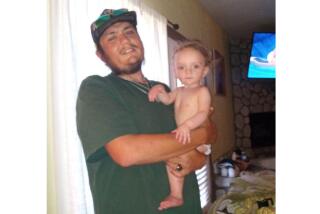Gruesome lye attack leaves woman struggling to survive
thetford, vt. -- This year, Carmen Tarleton wasn’t there to help her two daughters shop for school clothes. Nor did she see them off on their first day of school.
That late-summer ritual was left to close friends and relatives: Tarleton is fighting to recover from what one doctor calls “the most horrific injury a human being could suffer.”
Three months ago, Tarleton was burned over 80% of her body when she was doused with lye, allegedly by her estranged husband. She has undergone more than 16 skin grafts and has more to come.
Now blind, with one ear burned off and another damaged, the 39-year-old nurse remains heavily sedated in the intensive care unit of the burn center at Brigham and Women’s Hospital in Boston.
Hospital officials won’t release her condition, but family members say it is critical, although her vital signs are stable. Doctors are optimistic about Tarleton’s chances for an eventual cornea transplant that could restore her sight, but that’s months away.
“It’s pretty gruesome,” said her father, Joe Blandin, 64. “The best-case scenario is Carmen’s never going to be the same again. But we’re hoping that there’ll be enough quality of life.”
Herbert Rodgers, 52, her husband of nine years, is charged with burglary, aggravated assault and domestic assault in the June 11 attack. He is being held without bail at Southern State Correctional Facility in Springfield, Vt.
Rodgers and Tarleton were in the process of divorcing when Rodgers, believing she was seeing another man, went to her home intending to attack the man, according to prosecutors. When the man wasn’t there, Rodgers allegedly turned his sights on Tarleton, breaking in and pouring industrial-strength lye all over her, police said.
She also suffered a broken arm and broken eye socket in the attack.
“I just lost it,” police say Rodgers told them at the scene.
Police arrived to find Tarleton on the floor, her face distorted and her skin turning brown as she begged for an ambulance and tried to crawl into the shower to wash it off.
Tarleton, a veteran nurse at Dartmouth-Hitchcock Medical Center in Lebanon, N.H., was rushed there and later transferred to the Boston hospital, where she was so disfigured upon arrival that family members said all they recognized was her teeth.
A burn expert who has not been involved in her treatment says lye burns are among the most painful, destructive and difficult to treat, leaving victims scarred for life.
“It’s the most horrific injury a human being could suffer,” said Dr. Robert H. Demling, director of education and research for the burn center at Brigham and Women’s.
Typically, someone with third-degree burns over 80% of his body has a 50/50 chance of survival, he said. Initially, the biggest threats are shock and respiratory failure, and later infection. But the physical scars inevitably lead to emotional ones, he said.
“It’s a lose-lose situation. If she survives, it’s good. But many of these patients have terrible times coping with life after that, because of their identity loss and their disability,” Demling said. “They look at you and say, ‘Why did you bother?’
“But if they die, you have a person who leaves a family behind.”
In recent weeks, Tarleton’s doctors have eased up on her medication enough to allow her to regain consciousness on several occasions, and she has spoken with family members, according to her father. She knows what happened to her.
“She has talked about it, but not in detail,” he said.
Family members and friends have rallied to her side.
Kesstan Blandin, 40, one of her sisters, moved to Boston to be close enough to visit her daily.
“We just don’t want her to be alone, even if she’s not conscious,” said Kesstan Blandin.
Tarleton has shown small signs of awareness.
“There are different times when she becomes responsive, where she becomes lucid enough that I can tell she’s responding to my voice. She’ll move to me and grip my hand. Her daughters have seen her and she has moved her feet or her hands, an indication she hears you,” her sister said.
The girls, ages 12 and 14, are staying with close family friends, a couple in Lebanon, N.H., and have been embraced by their mother’s friends, who took them to water parks, pools and barbecues over the summer. Relatives took them on a vacation, and to Boston for a weekend of shopping for school clothes. Fundraisers helped pay for gift cards for clothes and supplies.
The girls, who see a therapist to help them with the trauma, are back in school and coping well, considering the circumstances, family members said.
“When people ask me, ‘How are the girls?’ I don’t know what to say,” Kesstan Blandin said. “The situation they’re in is so unheard of. We don’t even know what ‘good’ looks like in a situation like this.”
Said Joe Blandin: “Carmen was an incredible nurse, and an incredible mother. She believed in taking things just as they are, and rolling up your sleeves and getting down to it if it’s not to your liking. That’s what they’re doing. They’ve got their strength.”
Her father said the family’s focus remained on his daughter, not on Rodgers.
“We’re just trying to support Carmen and her two daughters. We’re not even thinking about the character who did this to her. We’re just supporting her and trying to get her through the woods,” he said. “It’s a day-to-day thing.”
More to Read
Sign up for Essential California
The most important California stories and recommendations in your inbox every morning.
You may occasionally receive promotional content from the Los Angeles Times.










